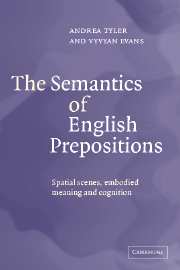Book contents
- Frontmatter
- Content
- Preface
- Acknowledgements
- 1 The nature of meaning
- 2 Embodied meaning and spatial experience
- 3 Towards a model of principled polysemy: spatial scenes and conceptualization
- 4 The semantic network for over
- 5 The vertical axis
- 6 Spatial particles of orientation
- 7 Bounded landmarks
- 8 Conclusion
- References
- Index
4 - The semantic network for over
Published online by Cambridge University Press: 22 September 2009
- Frontmatter
- Content
- Preface
- Acknowledgements
- 1 The nature of meaning
- 2 Embodied meaning and spatial experience
- 3 Towards a model of principled polysemy: spatial scenes and conceptualization
- 4 The semantic network for over
- 5 The vertical axis
- 6 Spatial particles of orientation
- 7 Bounded landmarks
- 8 Conclusion
- References
- Index
Summary
For a model of polysemy, it is not sufficient simply to describe the senses that exist in the network. We must also provide an explanation of how they came to be there and how they are distinct from locally constructed (i.e., on-line) meanings, which are not instantiated in memory. Our account will show how the model outlined in the previous chapter will achieve each of these objectives. For instance, we will employ our methodology for identifying distinct senses. We will illustrate how the notion of pragmatic strengthening serves to conventionalize implicatures that derive from language use and the nature of spatio-physical experience. We will also show how the inferencing strategies we discussed in chapter 3 serve to provide on-line interpretations, created for the purpose of local understanding. However, before proceeding with these issues, we must first identify the proto-scene for over, from which the other senses are derived diachronically in a principled manner. Accordingly, our discussion of over will serve as our primary illustration of how the model adduced in chapter 3 applies. Consequently, this chapter will be somewhat more detailed than most ensuing chapters.
The proto-scene for over
In chapter 3, we provided five linguistic criteria for adducing the primary sense associated with a semantic network. To illustrate the application of each of those criteria, we used over as our primary example.
- Type
- Chapter
- Information
- The Semantics of English PrepositionsSpatial Scenes, Embodied Meaning, and Cognition, pp. 64 - 106Publisher: Cambridge University PressPrint publication year: 2003



